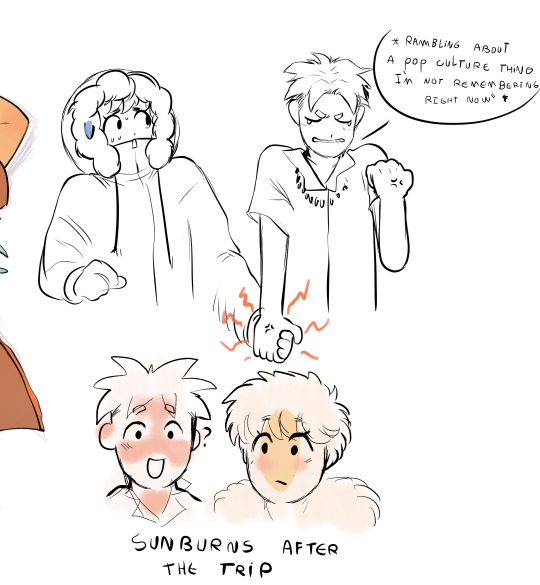Text
Looks like I won’t be marrying Penelope…
Hopefully the upcoming film will have enough budget for the other 11 axes!
BTS, art refs and more here
4K notes
·
View notes
Text

This was hard but here we go. Remember that spoilerish comic with the Digimon Kaiser? Well, it's part of my ideas about Rui being involved in 02 TV Series events.
I'm still thinking how to make it work but I can at least draw a few panels with him interacting with the 02 kids/ArukeniMummy/etc…
22 notes
·
View notes
Text

💥💥💥 f i g h t 💥💥💥
54 notes
·
View notes
Text

Rui: You think that the digimon are just toys, right?
Rui: But they are dangerous creatures serving us. (That's why you keep getting butt kicked)
Ken: (If you don't want to play, why are you here then?!)
[ Both are totally WRONG ♡ ]
I still think about how Rui also had a very wrong view of the digimon thanks to Ukkomon's statements, and maybe why he kept believing that the digimon-human relationships were BAD.
It's not like he wanted the digimon to protect their partners and fight until they die, he doesn't want that in this AU thing either.
The thing is, he believes that digimon's only purpose is to serve humans, and he's pretty much against that idea, too. But if the only digimon you knew in your life was the one that was paired with you, and it was a creature of the UNHINGED...
He hates the fact that the digimon who partnered with humans are fated (lol) to serve their humans for the rest of their lives and fight until they die.
And yes, Rui probably thinks that Ken forced a ton of digimon to become his partners? Since Rui has no idea how partnerships work and stuff...
Ah, i was musing about this friggin AU again, oops?
11 notes
·
View notes
Note
Is there anything different about Chimeiramon/Kimeramon in √02? Do they interact with Rui?
Nope! I was toying with the idea that Rui & Ukkomon's roles in the original 02 storyline were between episodes, so...
He probably heard about it when Wormmon freed him (out of jealousy, like in Agumon's case in the canon) and just...

A human creating a digimon life is really TERRIFYING AND WRONG.
(Don't let him know about Arukenimon and Mummymon's origins and lore in 02 lol).
I don't know (yet) if he witnessed the fight or not -- probably not, he would have been easily spotted in the desert in the events of this episode? -- so I guess he has no interactions with Chimeramon, sorry.
6 notes
·
View notes
Text

Wormmon: You are stealing MY Ken-chan by making him pity you!!
Wormmon: So leave now, don't come back!
Rui: (What is this digimon walking about??)
Rui: (Ichijouji-kun is pitying me??!)
√02 Rui and Wormmon.
Wormmon is really jealous because his Ken-chan cares more about the others than him (which is a lie, despite all the digimon abuse, Ken can't put a ring on him or let him be part of a Digi-Battle because Ken-chan doesn't want that stupid hornworm to get hurt.)
Rui has never had anyone feel sorry for him or anything, unless you count Ukkomon, but yeah.
18 notes
·
View notes
Text

I decided to re-do the doodle i made of kid Rui with beta Rui's design outfit. This time with the eyepatch because it's actually an edit over the custom design I made.
(yeah, i changed the shoes and socks from Nakatsuru-sensei's beta design.)
So yeah, more... √02 stuff :V
19 notes
·
View notes
Text

Ukkomon: Rui is just ungrateful!! I was trying to help him, hmph!
Gomamon: YOU GAVE YOUR EYE TO HIM, DUDE!!
Gomamon: Yo could've ASKED first!! No wonder he snapped at you!!
Agumon: [nods in silence]
Ukkomon is just stubborn as Rui in this AU sorry folks lol.
More... √02 stuff. No one asked but I'm enjoying to write this one AU down lol.
12 notes
·
View notes
Text

Unfitting...?
8 notes
·
View notes
Text






























Daily Rui-kun Doodle project part 10
12 notes
·
View notes
Text



I'm finally free from commissions so I'm drawing bunny to clean the rust off a bit
988 notes
·
View notes
Text

this special was the first sp related thing I watched back in September since 2010 and as a shipper from back then it felt like out of body experience.
890 notes
·
View notes
Text
been getting back into south park so i did some sketching 🙂




882 notes
·
View notes
Text


Sketch dump of them eating 🍔 minus cartman
2K notes
·
View notes
Text
Lui is computer hacker ? But is 100% perfect 🤩 ,💯

SF + ハンバーガー ? !
⚛️ + 🍔 ? !
9 notes
·
View notes
Text




//drops ship content and leaves again
check out my commissions
#digimon adventure#digimon#digimon adventure 02#digimon frontier#kimura kouichi#yagami hikari#motomiya daisuke#ohwada lui#ichijouji ken#inoue miyako#takaishi takeru#kouikari#miyaken#minamoto kouji
31 notes
·
View notes
